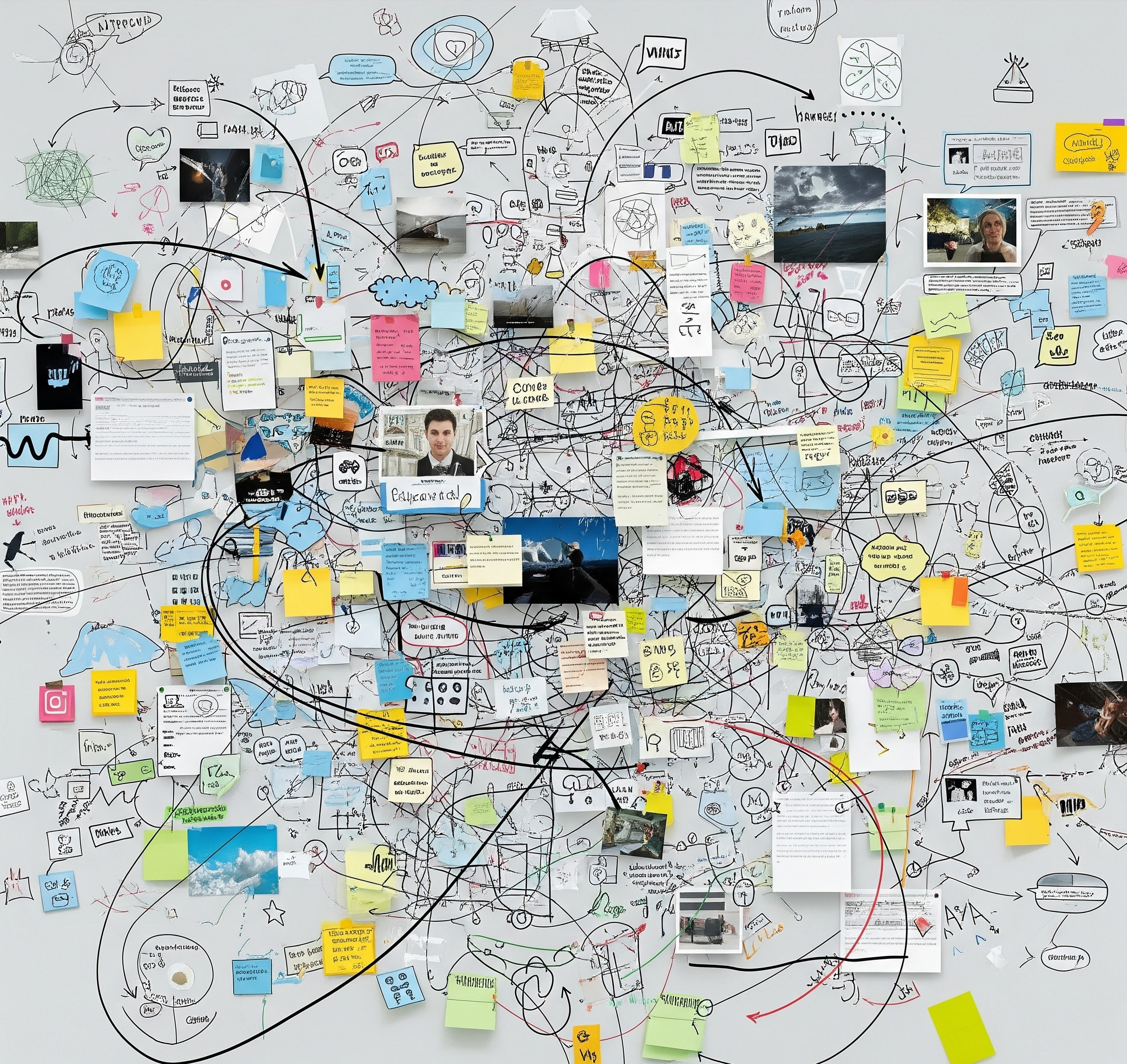Why Online Whiteboards
Fail Enterprise Workshops
Online whiteboards promise collaboration – but in enterprise workshops they often create chaos, inefficiency, and higher costs.
Whiteboards became the go-to tool for remote collaboration. But in enterprise workshops, they often magnify inefficiencies instead of solving them. (See our comprehensive Digital Workshops Guide for structured workshop methods that address these challenges.) Without structure, decisions get lost, documentation becomes a burden, and alignment breaks down. This article explores why whiteboards fall short – and what structured digital workshops do differently.
What Are Online Whiteboards Missing in Enterprise Workshops?
Online whiteboards like Miro and Mural have become popular collaboration tools. Yet many enterprises still struggle with workshop inefficiencies even after adopting them. Why online whiteboards fail enterprise workshops? The issue is not the technology itself but the gap between what these tools provide and what enterprise workshops actually require.
Digital whiteboards are essentially infinite canvases that replicate physical whiteboards in a virtual space. Teams can add sticky notes, sketch diagrams, and collaborate visually. However, enterprise-scale workshops demand more than a digital drawing board. They need structured methodologies, the ability for all participants to contribute in parallel, and bias-free decision-making processes.
In practice, online whiteboards often amplify the very problems they aim to solve. Setup can take hours, with facilitators spending more time preparing boards than running the workshop. Performance drops significantly in large groups as hundreds of sticky notes accumulate. Most critically, workshops still follow the same sequential, turn-based discussion that slows down traditional meetings. Visible voting fosters bias, and production blocking prevents participants from contributing simultaneously. The result is inefficiency at scale.
7 Critical Limitations of Online Whiteboards in Enterprise Workshops
Our analysis of enterprise workshop failures reveals eight fundamental limitations that make online whiteboards ineffective for serious business collaboration:
1. Excessive Setup Complexity
Creating professional workshop boards takes hours, not minutes. Facilitators report spending 3-6 hours (or even weeks) preparing a single workshop board, with complex permission settings, template configurations, and participant onboarding consuming valuable time that should be spent on actual collaboration. This preparation overhead becomes particularly problematic for recurring workshops where the same setup complexity must be repeated every session.
2. Cognitive Overload and Zoom Fatigue
Participants must simultaneously manage video conferencing, navigate complex whiteboard interfaces, and contribute ideas. This constant context-switching between tools creates cognitive overload, reducing creative output by up to 40% compared to focused collaboration methods. The overwhelming array of features, icons, and options distracts from the actual workshop objectives. In enterprise workshops, missing non-verbal cues in video conferencing can contribute to so-called Zoom Fatigue, leading to health effects such as exhaustion and reduced focus.


3. Sequential Contribution Bottlenecks
Despite being digital, online whiteboards still enforce turn-based participation. While one person speaks or adds content, others wait. This production blocking wastes 60-70% of workshop time and prevents the parallel contribution that makes workshops truly efficient. The result is that a 3-hour workshop could deliver the same outcomes in 45 minutes with proper parallel processing.
4. Mixed Ideation and Evaluation Phases
Online whiteboards catastrophically mix divergent thinking (idea generation) with convergent thinking (evaluation), creating a toxic environment for innovation. When participants can immediately comment on, criticize, or vote on ideas as they appear, it triggers premature judgment that kills breakthrough thinking before it can develop.
This fundamental design flaw creates psychological safety issues where contributors self-censor innovative thoughts, knowing they’ll face instant criticism. Teams default to “safe” conservative ideas rather than exploring transformative solutions. When ideation and evaluation are properly separated, teams generate more innovative solutions and achieve higher participation rates. Yet online whiteboards make this separation nearly impossible, forcing teams into a pattern where the loudest critics shape outcomes rather than the best ideas winning on merit.
Enterprise workshops need protected ideation phases where all ideas can emerge without judgment, followed by structured anonymous evaluation based on objective criteria. This separation is what transforms workshops from political exercises into genuine innovation engines.
5. Visible Voting Creates Bias
When participants can see how others vote or prioritize ideas, social dynamics override objective decision-making. Senior leadership opinions dominate, innovative ideas from junior members get suppressed, and groupthink replaces genuine consensus-building. Anonymous contribution methods show up to 3x more innovative ideas compared to visible voting systems.
6. Lack of Structured Methodologies
Online whiteboards come with hundreds of templates – so many that it’s often hard to see the forest for the trees. But colorful layouts and boxes don’t define a real process. What truly matters in workshops is the separation of phases: ideation, evaluation, and discussion. Since whiteboards don’t enforce these steps, facilitators are left to design the flow themselves. And even if they build their own process, moving ideas from one phase to the next requires manual effort – sometimes even in the middle of the workshop. This interrupts the flow, distracts from the actual discussion, and is error-prone: in the rush of facilitating, important ideas can get lost or mishandled.
7. Poor ROI Despite High Costs
Enterprises often invest in online whiteboards because of their sleek design and long feature lists. But few teams ever stop to measure whether these tools actually deliver a productivity gain. In many cases, participants are dazzled by visuals and features, while overlooking the hidden effort required to prepare, moderate, and process results. Add to that the licensing costs needed to ensure everyone can participate, and the total ROI often turns negative – high cost with little measurable impact.
The Solution: Structured Digital Workshops That Actually Work
The path forward for enterprises is clear: move beyond visual collaboration tools to purpose-built workshop platforms that address the root causes of meeting inefficiency. Here’s how industry leaders are transforming their workshop outcomes:
1. Implement Parallel Contribution Methods
Replace sequential discussions with simultaneous input. When all participants contribute ideas at once, a 3-hour workshop generates more actionable insights than a 3-day traditional session. This parallel processing eliminates production blocking and ensures every voice is heard, not just the loudest.
2. Apply Anonymous Evaluation Techniques for Better Decisions
Simple voting can reduce bias, but it rarely captures the full picture in enterprise workshops. Important perspectives are often lost when complex decisions are reduced to a single vote count. Structured digital workshops enable multi-criteria evaluation framework – from multi-criteria scoring to perspective-based ranking – all conducted anonymously. This ensures every voice is represented, decisions are based on more than popularity, and outcomes reflect balanced enterprise priorities.
3. Deploy Proven Workshop Methodologies
Deploy proven workshop methodologies instead of relying on free-form whiteboard sessions. Online whiteboards provide blank canvases but lack built-in methodological structure – they don’t guide teams through proven processes or enforce best practices. Without embedded methodology, sessions devolve into unstructured discussions where participants can comment and judge ideas immediately, breaking fundamental workshop principles. Proven methodologies like Brainwriting, Random-Word-Technique, or Impact/Effort Analysis require strict phase separation: idea generation without evaluation, then structured assessment, then prioritization. These methodologies work because they prevent premature judgment – participants know that commenting is blocked during ideation and evaluation happens anonymously in a later phase. Online whiteboards can’t enforce these rules; anyone can add comments or start debating at any time. When you deploy structured methodologies with enforced phases and anonymous evaluation, workshops produce consistently better outcomes regardless of facilitator skill – something free-form whiteboard sessions cannot guarantee.
4. Automate Documentation and Follow-Up
Eliminate the post-workshop documentation burden that online whiteboards create by design. Because whiteboards are free-form canvases, exported content arrives as unstructured, uncategorized sticky notes – even when exported to Excel, you get rows of disconnected text without context, hierarchy, or relationships. Someone must manually spend hours categorizing ideas, identifying themes, determining decisions, and extracting action items from hundreds of scattered notes. This post-processing nightmare means critical insights get lost and follow-up happens days or weeks later when momentum has died. Structured workshop platforms instead capture content in predefined categories from the start – ideas are tagged by theme, decisions are marked with rationales, and action items are assigned during the session. The result: automatic generation of organized reports with clear sections for decisions made, actions assigned, and ideas prioritized. Participants receive structured documentation immediately, maintaining momentum and ensuring accountability. What takes hours of manual processing from whiteboard exports happens automatically when workshops use proper structure from the beginning.
What Enterprises Leaders Say

Want the full side-by-side breakdown?
Download our free PDF guide: Online Whiteboards vs. Structured Digital Workshops. See how enterprises save time, reduce costs, and make faster decisions with the right methods.